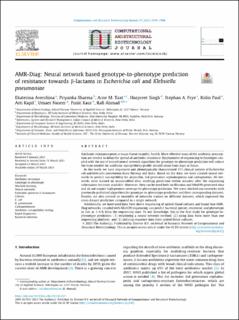| dc.contributor.author | Avershina, Ekaterina | |
| dc.contributor.author | Sharma, Priyanka | |
| dc.contributor.author | Taxt, Arne Michael | |
| dc.contributor.author | Singh, Harpreet | |
| dc.contributor.author | Frye, Stephan Alfons | |
| dc.contributor.author | Paul, Kolin | |
| dc.contributor.author | Kapil, Arti | |
| dc.contributor.author | Naseer, Mohammed Umaer | |
| dc.contributor.author | Kaur, Punit | |
| dc.contributor.author | Ahmad, Rafi | |
| dc.date.accessioned | 2021-11-12T14:20:13Z | |
| dc.date.available | 2021-11-12T14:20:13Z | |
| dc.date.created | 2021-04-22T11:51:53Z | |
| dc.date.issued | 2021 | |
| dc.identifier.citation | Computational and Structural Biotechnology Journal. 2021, 19 1896-1906. | en_US |
| dc.identifier.issn | 2001-0370 | |
| dc.identifier.uri | https://hdl.handle.net/11250/2829397 | |
| dc.description.abstract | Antibiotic resistance poses a major threat to public health. More effective ways of the antibiotic prescription are needed to delay the spread of antibiotic resistance. Employment of sequencing technologies coupled with the use of trained neural network algorithms for genotype-to-phenotype prediction will reduce the time needed for antibiotic susceptibility profile identification from days to hours.
In this work, we have sequenced and phenotypically characterized 171 clinical isolates of Escherichia coli and Klebsiella pneumoniae from Norway and India. Based on the data, we have created neural networks to predict susceptibility for ampicillin, 3rd generation cephalosporins and carbapenems. All networks were trained on unassembled data, enabling prediction within minutes after the sequencing information becomes available. Moreover, they can be used both on Illumina and MinION generated data and do not require high genome coverage for phenotype prediction. We cross-checked our networks with previously published algorithms for genotype-to-phenotype prediction and their corresponding datasets. Besides, we also created an ensemble of networks trained on different datasets, which improved the cross-dataset prediction compared to a single network.
Additionally, we have used data from direct sequencing of spiked blood cultures and found that AMR-Diag networks, coupled with MinION sequencing, can predict bacterial species, resistome, and phenotype as fast as 1–8 h from the sequencing start. To our knowledge, this is the first study for genotype-to-phenotype prediction: (1) employing a neural network method; (2) using data from more than one sequencing platform; and (3) utilizing sequence data from spiked blood cultures. | en_US |
| dc.language.iso | eng | en_US |
| dc.rights | Navngivelse 4.0 Internasjonal | * |
| dc.rights.uri | http://creativecommons.org/licenses/by/4.0/deed.no | * |
| dc.subject | Artificial Neural Networks | en_US |
| dc.subject | Artificial Neural Networks | en_US |
| dc.subject | Maskinlæring | en_US |
| dc.subject | Machine learning | en_US |
| dc.title | AMR-Diag: Neural network based genotype-to-phenotype prediction of resistance towards β-lactams in Escherichia coli and Klebsiella pneumoniae | en_US |
| dc.type | Peer reviewed | en_US |
| dc.type | Journal article | en_US |
| dc.description.version | publishedVersion | en_US |
| dc.subject.nsi | VDP::Genetikk og genomikk: 474 | en_US |
| dc.subject.nsi | VDP::Genetics and genomics: 474 | en_US |
| dc.subject.nsi | VDP::Genetikk og genomikk: 474 | en_US |
| dc.subject.nsi | VDP::Genetics and genomics: 474 | en_US |
| dc.subject.nsi | VDP::Genetikk og genomikk: 474 | en_US |
| dc.subject.nsi | VDP::Genetics and genomics: 474 | en_US |
| dc.source.pagenumber | 1896-1906 | en_US |
| dc.source.volume | 19 | en_US |
| dc.source.journal | Computational and Structural Biotechnology Journal | en_US |
| dc.identifier.doi | 10.1016/j.csbj.2021.03.027 | |
| dc.identifier.cristin | 1905827 | |
| dc.relation.project | Norges forskningsråd: 273609 | en_US |
| cristin.ispublished | true | |
| cristin.fulltext | original | |
| cristin.qualitycode | 1 | |

